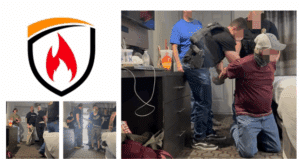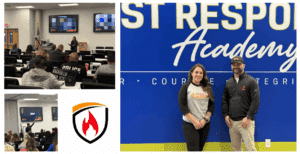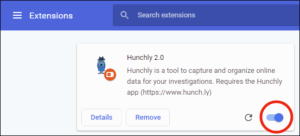In This Issue
- Operational Support to Oklahoma PD: Four MORE Predators Arrested
- Member Highlight: Julie Beck, a Survivor to Hunter Story
- OSINT Tradecraft: Professional OSINT Research
Who We Are
The Skull Games Task Force employs Open Source Intelligence to IDENTIFY sexual predators and their victims, enabling law enforcement to INTERDICT the cycle of abuse. Our mission is to EMPOWER survivors with the opportunity for a life of hope, healing, and freedom. The Task Force provides direct support to law enforcement through small teams or as a massive expedition, bringing together the collective capability of more than 400 elite volunteers. This counter-sexual exploitation offensive leverages considerable expertise and resources to fight human trafficking and sexual exploitation. With us as the HUNTERS, we get into the heads of predators, in our own “SKULL GAME”…
Learn more about Skull Games
Operations Summary – April 2025
by Olinda Cardenas
- Law Enforcement operations supported: 3
- Sex Predators Arrested: 21
- Victims Recovered and offered services: 3
- People trained in Counter-Trafficking: 23
Recent Operation Summary:
The month of April was busy for the Skull Games team as they provided remote support to various law enforcement agencies across Oklahoma, to include the Oklahoma’s District 27 Drug and Violent Crime Task Force and the Oklahoma Attorney General’s Human Trafficking Response Unit to combat human trafficking. This joint operation led to the arrest of four sex predators, including a former Arkansas Department of Human Services employee, and the identification of two potential victims who were then connected with essential support services.
The proximity of these crimes to everyday community spaces underscores the pervasive nature of trafficking. Skull Games’ partnership with local authorities highlights the critical role of community collaboration in addressing and preventing such exploitation.

**We do not release identities due to the nature of various state laws, and reserve that for our law enforcement partners as they deem appropriate**
To close out April, Skull Games made an impact in Durant, Oklahoma. In partnership with Attorney General Gentner Drummond’s Human Trafficking Response Unit, the Durant Police Department, and the District 19 District Attorney’s Office, Skull Games participated in a two-day advanced human trafficking training session for local law enforcement.
The training culminated in an undercover operation carried out by 24 law enforcement officials in Bryan County, resulting in the recovery of at least one human trafficking victim and the identification of additional potential victims. Three individuals were arrested for soliciting prostitution, and one was arrested for sex trafficking.

More on the operation can be found here.
Training Provided – April 2025
by Olinda Cardenas
April kicked off with momentum as the Skull Games trailblazers on the frontlines traveled to Texas in partnership with Amarillo College to deliver a two-day advanced counter-sex trafficking training to law enforcement in the Texas Panhandle. A total of 23 personnel from various local and state departments—including the Texas Department of Public Safety, Amarillo P.D., Lubbock P.D., and the Office of the Inspector General—participated in the training. Additionally, another 120 individuals from fields such as medicine, mental health, education, and advocacy joined for a half-day session on the “multidisciplinary approaches to human trafficking” portion of the training.
As Joseph Scaramucci put it:
“For those wishing to exploit others: know that law enforcement in the Texas Panhandle is VIGILANT, PROFESSIONAL, and UNWAVERING in its pursuit of justice.”
Shortly after the training concluded, participating agencies applied the methods taught and in just over an hour of practical application, were able to identify five victims and three to four buyers in Texas, generating actionable intelligence. All participants indicated the training broadened their knowledge in the field and expressed appreciation that the Skull Games training team brought their expertise to the Texas Panhandle.

The team also conducted training in Cape Cod the following week, which participating agencies indicated the training is like no other currently offered and were eager to use their new OSINT knowledge for GOOD!
Member Highlight: Julie Beck, a Survivor to Hunter Story
by Tom Phelan
Sometimes at Skullery, we would like to take a break from the dreary news and shine a light on our people who are shining lights in the OSINT community. Julie Beck, a passionate and tenacious Task Force Member, has a story we need to get out. Her journey from survivor to hunter is inspiring and, unfortunately, somewhat common to our ranks. She has a story that will help others, and is kind enough to share it with us.
On March 6th, Julie shared a condensed version of her story at ProtectCon, bravely speaking about surviving domestic violence and abuse. Her early life was shaped by medical trauma, seizures that began at age two and worsened with time. Despite countless re-diagnosis by doctors and 26 pills a day, her condition was often dismissed as psychosis. As a very vulnerable 15-year-old, Julie was targeted. A man 14 years older, in a position of authority within her religious community, manipulated and exploited her desire for healing. Her story represents a chilling reality, that Predators will use a position of power to target the vulnerable and treat a victim’s best qualities as vulnerabilities. Julie’s story is one such case, a psychopath who targeted a child and used religion as a weapon.
In 2005, Julie found true healing, despite the odds. A referral to Emory University Hospital revealed epileptic activity, and on March 1st, 2006, she underwent brain surgery. She’s been seizure-free ever since. That milestone marked the beginning of a new chapter. “I decided I’d never be codependent on a toxic relationship again,” Julie says, and she meant it. From there, she dove into education, joined the professional world, and began using her experience to help others. Julie now volunteers with several non-profits, including Operation Safe Escape, where she serves as Director of Intelligence. Her team supports survivors through threat assessments and digital safety recommendations.
She’s also launching a Capture the Flag called Operation Phoenix and heading up an applied intelligence initiative targeting Child Sexual Abuse Material predators online. Julie even works to blend her profession with her mission. In her day job, she manages the security of ATMs across the U.S. She used this as an opportunity to help by displaying missing persons from the National Center for Missing and Exploited Children on more than 8,000 ATMs.
A short blog post does not do Julie’s story justice, so we invite you to explore it further in her published work, A Quest for the Norm, available on Amazon. We thank Julie for all she does for our community and for sharing her story. To anyone with a similar story, know that it is possible to break the cycle of abuse. Your first step is recognizing that you are being abused, which can be hard. Julie’s presentation, available through Operation Safe Escape on YouTube, helps to identify when you are in a cycle of abuse and what to do next. To anyone who feels trapped, whether you know you are being trafficked or think you feel trapped at home: know that there is help for you. Organizations like Operation Safe Escape and Skull Games Solutions are dedicated to providing the support and resources needed to reclaim your life. Hopefully, Julie’s bravery in speaking out against abuse, empowers more to break the cycle of abuse and go from SURVIVOR TO HUNTER.
OSINT Tradecraft: Professional OSINT Research
by Tom Phelan
Who among has experienced this: you are shopping online but didn’t save the item to your cart, and now you can’t find it again? Annoying right? What about when you had a school assignment and you forgot to press save and had to re-do hours of work when your computer froze. Devastating. It’s happened to me while writing this blog, even. What about when you are an OSINT practitioner and you didn’t take proper notes, your path of discovery is lost, and you can no longer provide the necessary intelligence to law enforcement or military. Do you see how the problem is the same but with radically increasing stakes. Today we talk about how to avoid the risk of lost effort with proper tradecraft.
“Show me the money!”, to make an outdated reference. Or more aptly show me the keywords you searched, the webpages/apps/software programs you used, source URLs you found, screenshots of work, the logic of your analysis, and many other details that amount to a proper OSINT ‘path of discovery’. For OSINT practitioners, documenting your process is just as important as the discovery itself. Whether your lead ends up in the hands of law enforcement or another analyst picks up where you left off, your notes are the breadcrumbs that turn a lucky break into an actionable case. Here’s how to make your work matter.
Write Like You’re Not Coming Back
Start every session assuming there will be a worldwide electrical blackout, or you will fall in a well at any moment. Take local notes as you go, don’t rely on browser history. Download key media (images, videos, PDFs) and name them descriptively. Use tools that autosave your session (like Hunchly or Obsidian). Keep a USB or external SSD as a backup store for key files, especially if you’re traveling or working off a borrowed machine. On whatever notetaking means you use (other than pen, paper, and/or typewriter), hit that save button often. To make sure what you save is valuable, document the 5Ws for every piece of the puzzle.
Who/What you searched for
Where you searched
When you searched
Why you searched there/Why it matters (Anyone can paste links. Analysts leave a trail of reasoning. When you pivot from an image to a username, or a username to a Telegram group, always document why. Your thinking becomes just as valuable as your findings).
Think of it like leaving a field journal for the next explorer in the vast wasteland called the internet. This mindset keeps you focused and accountable. Note, there is a distinction between searching/researching and collecting. Don’t make the mistake of only taking a note when you think you found something valuable and collect it (taking a screenshot or copying text). You don’t always know what was important until much later in your investigation, so you need to be able to recreate ALL of your research.
Here is an entirely made-up example: Searched keywords “Ariannna + Arizona + escort” on Google. Narrowed to photos found on SkiptheGames. Matched tattoo on right wrist from her missing persons poster. Pivoted to Instagram handle found via image search (“ari.az”), now scraping content for location clues. This note tells me what I was searching, how to recreate the search, and most importantly, my logic.
Not every collection of information will contain a valuable result, but a detailed note can further the story with intimations about a trail of clues (some that deny assumptions, some that confirm them). I know what you are thinking. This seems like a lot of work. That’s because it is, and not cutting corners is the difference between amateurs and professionals.
Screenshots Are Not Notes (But They Help)
Screenshots are great, but they don’t tell the full story. A small thumbnail and a filename 12345689.jpg, litters the file folders of all our computers. Is it an important piece of OSINT or is it meme? I don’t know. So, pair every image with a descriptive filename, a caption in your notes explaining what it shows, a URL, timestamp, and save it in a folder dedicated to this current project.
Helpful Tools:
ShareX – auto-labels screenshots and saves them to folders.
Flameshot – fast and customizable annotation tool.
Hunchly – captures every site visited, with automatic screenshots and metadata logging.

Establish a Rallypoint
In the military, they put a lot of emphasis on not getting lost. One way to do this is to create a rallypoint before a major event. A leader will designate a place to stop to before laying down to rest, crossing a river, or engaging an enemy, because it allows the unit to ensure they are ready for what comes next and also gives a place to fall back to if things go to hell. An OSINT analyst might not need a rallypoint because they need to go blow up a bridge but they might need to get it together before they go take a nap or microwave some popcorn. Before you step away from your computer for more than a minute or tab out to shop for Mother’s Day, establish a Rallypoint:
Save notes locally, to an encrypted drive, and/or a secure cloud storage/portal (don’t trust unsecure clouds when working with sensitive material). But DO NOT just save it to YOUR desktop. What if your computer falls in a well? Save it to where it’s backed up and secure, but also shareable to specific people. If you are working as a team, you want your work to be discoverable and in a document format that enables collaboration. I recommend saving notes to a spreadsheet document, with a standardized format, that is shared only to specific users. PDF is fine but harder to sort through. Remember this is not a presentation of all your findings, so it doesn’t need to be in slides or word docs. Use a consistent filename format like Case1_Capture10_Tattoo_05052025.jpg. Now that you have done some data management you and your team can rally to catch predators.
Source Everything Like It’s Your Final Exam
If you quote a post, copy an alias, or download a photo, log the platform (e.g. Instagram, Escort Index), the exact date/time you accessed it, the profile or post URL, and any archive or hash you generated. Websites data can get lost in any number of ways, it can be breached, deleted, aged off, archived, etc. To find it again in a wayback machine you would like to know where it was and when it was. Also, if this is to be valuable intelligence to a customer, they want to know the exact URL for data validation as well as how current the information is.
Helpful Tools:
SingleFile – saves full web pages with metadata.
Wayback Machine (archive.org) or Archive.today (archive.ph) – always back up vanishable links.
Use Tags to Quickly Index and Connect Dots
Use simple tags in your notes like: #escort-profile, #possible-trafficker, #geo-pivot, #social-lead. This makes it easier to find past cases and cross-reference common elements. There’s a reason social media sites do this. This format is machine readable which makes it easy to query in search functions of any OS or database. It’s also digital shorthand, so you can do it quickly and repetitively.
Final Thoughts
OSINT isn’t magic, it’s method. Organized, transparent notes build trust with teammates, amplify impact, and make your work usable beyond a single weekend. If you have trouble with this because you are new to OSINT or are inherently disorganized/scatterbrained, or you just want to streamline things, there are subscription-based tools Hunchly, Obsidian, and Loqseq that can help you. Remember we’re not just browsing; we’re building bridges to action. So, plan for failure. Save like it matters. And work like someone’s freedom depends on it. Because sometimes, it does.
Upcoming Events
- Task Force Expedition XVI | August | Austin, TX
- Task Force Expedition XVII | October | Arlington, VA
Skull Games Links
- Social Media: Follow Us linkedin facebook insta twitter
- Donations: Support Us
- Law Enforcement: Partner With Us
- Volunteer: Join Us
About the Author

Tom Phelan is an active-duty U.S. Army Intelligence Officer with over five years of experience in OSINT and a dedicated volunteer for Skull Games Task Force.

Olinda Cardenas is a former crime scene investigator turned cybercrime enthusiast. She specializes in OSINT and financial crime investigations and is a dedicated volunteer with Skull Games



